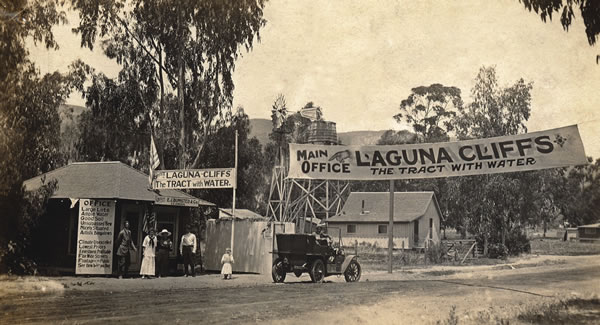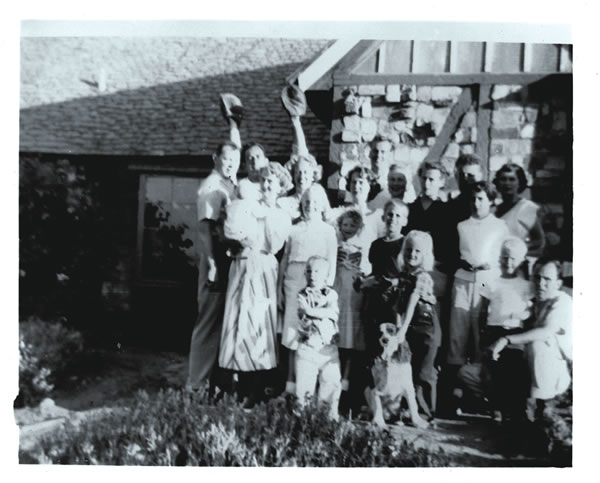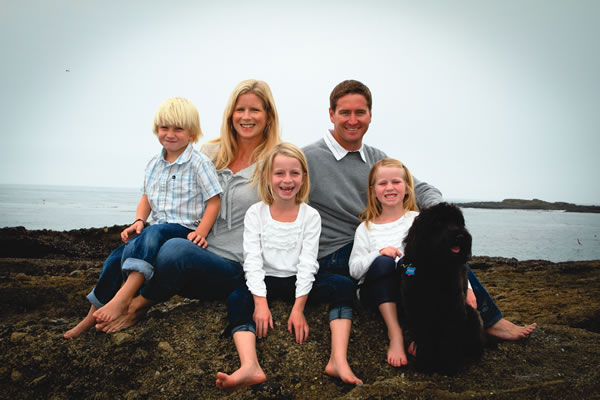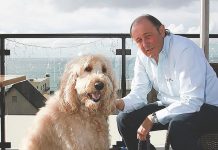Deeply Rooted
Laguna’s multigenerational families recount the histories, memories and changes they’ve seen through decades of living here.
By Cheryl Pruett
Whether you’ve lived in Laguna Beach for years or are visiting for the first time, it’s easy to see that this city is hard to leave. And that’s especially true of Laguna’s most well-known multigenerational families—those who have made this city their home for decades and, in some cases, more than a century. For these families, staying in Laguna goes beyond the allure of a beautiful seaside village; it’s the origin of their histories. And while over the decades buildings have changed and demographics have shifted, these families have stayed grounded.
“[Laguna has] an amazing root system,” says Erica Brauer Jones, 39, whose great-grandfather Anton Duke Kluewer owned Laguna’s first liquor store on Glenneyre Street. “The town means a lot to me. You have to have some kind of roots.” Erica has the distinction of being born in Laguna Beach—at a home in Bluebird Canyon. Growing up in Laguna, she has a family history that includes nearly everyone from her father to brother going to Thurston Middle School. She lives here with her husband and two sons, Cameron, 13, and Carter, 11.
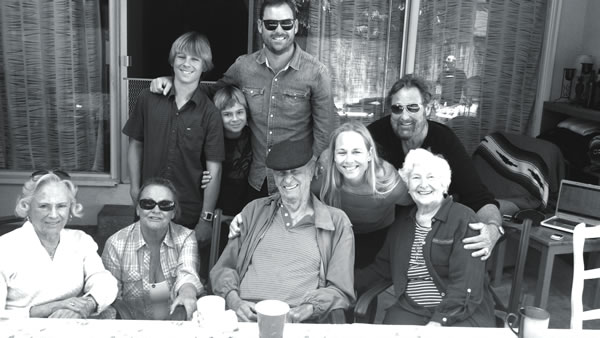 The list of multigenerational families in Laguna Beach is long and filled with names many locals would recognize. The Abels, the Jahrauses, the Williamses and the Kluewers. And that’s only the short list. Almost all of the multigenerational families of Laguna Beach know one another and are linked in many ways—attending the same schools throughout the generations, working for one another’s businesses or simply watching out for one another.
The list of multigenerational families in Laguna Beach is long and filled with names many locals would recognize. The Abels, the Jahrauses, the Williamses and the Kluewers. And that’s only the short list. Almost all of the multigenerational families of Laguna Beach know one another and are linked in many ways—attending the same schools throughout the generations, working for one another’s businesses or simply watching out for one another.
“There’s a sense of history and belonging that I like,” says fourth-generation Lagunan William Jahraus, 27, son of Joe Jahraus, 64, and nephew of Jeff Jahraus, 61, all Laguna residents. “Laguna actually has a downtown. There’s a sense of camaraderie in Laguna Beach High School students and locals who are around for ages.”
The Jahraus’ history began in 1902 when Jeff and Joe’s great-grandfather Elmer Jahraus came to Laguna Beach and opened a cigar factory. Later, Elmer’s son, Joseph (Jeff and Joe’s grandfather), founded Laguna Beach Lumber Co. in 1912. Joseph’s son Richard then took over the family business until his sons Jeff and Joe bought the company in the 1980s. In 2001, it was sold to Ganahl Lumber Co. According to city records, an estimated 90 percent of the older buildings in Laguna were built from wood from the family’s company.
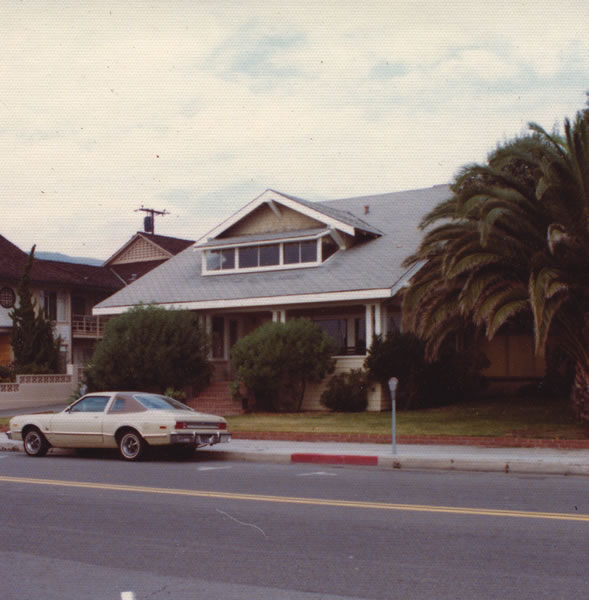 When Elmer first arrived in 1902, there were about only 11 permanent families living in town. Elmer, who made cigars in the original Hotel Laguna, was also the first realtor in the town, selling lots along Cliff Drive. In 1929, Elmer was instrumental in saving what was to become Heisler Park. When developer Howard Heisler decided to go back on his promise to dedicate the land as a park, Elmer stepped in with a lawsuit and won. Ultimately, the land became Heisler Park.
When Elmer first arrived in 1902, there were about only 11 permanent families living in town. Elmer, who made cigars in the original Hotel Laguna, was also the first realtor in the town, selling lots along Cliff Drive. In 1929, Elmer was instrumental in saving what was to become Heisler Park. When developer Howard Heisler decided to go back on his promise to dedicate the land as a park, Elmer stepped in with a lawsuit and won. Ultimately, the land became Heisler Park.
Jeff and Joe’s father, Richard, now 88, was born in 1925 in Laguna Beach and still lives on Cliff Drive in a home he built in 1977 on the site of the original 1912 family home. The Jahrauses have owned land in Laguna Beach for more than 100 years, including the residential land on Cliff Drive—the site of the original Jahraus’ family home in 1912—and the land downtown on Forest Avenue, where the old Laguna Beach Lumber Co. used to be.
Richard remembers when he was in his 50s—more than 30 years ago—the good times he had swimming in the ocean, diving for abalone, spearing halibut and rowing his dory up and down the coast. Jeff Jahraus also remembers when the family moved into the original Cliff Drive house in 1952 (before it was rebuilt in 1977). “My grandfather still had a house up on Top of the World,” Jeff says. “My father thought about moving there, but it [had] no piped water. It was like going out in the country.” That’s when Old Top of the World was totally open, he recalls.
Jeff Jahraus says, “Family roots and lots of friends keep us in Laguna.”
A Village Feel
Charles “Charlie” K. Williams, an architect, is part of double multigenerational families in Laguna Beach. Born at South Coast Hospital (now Mission Hospital), the 38-year-old Charlie met his wife Sarah Golden in junior high school in Laguna. Sarah’s mother, Jane Golden, who lives in town, and Charlie’s father, Charlie D. Williams, 62, of Williams Construction, play big roles in family life in this multi-multigenerational family.
“For me, I always opt to live in a true small town,” says the younger Charlie. “It takes a village to raise a child; I’ve always taken that to heart. I’m a product of that. I have had the opportunity to be raised by a village. It played an instrumental role in my life. My kids still benefit from the village atmosphere—there’s a certain amount of safety. It’s more than just you watching out for your kids.”
Charlie also believes that another thing that sums up Laguna is its diversity—people, buildings and economic status. He believes his father, Charlie D. Williams, epitomizes a Laguna spirit through the homes he built, the help he provided during the Bluebird landslide and even his work at the Pacific Marine Mammal Center, where he did a lot of the most recent renovation work, including the new pools.
Next are the Abels, whose family roots date back to 1937. Carl “Pop” Abel, a wood carver and antique dealer, left a legacy that has grown more than 76 years. Generations of more Abels have enhanced the legacy, including Chris and Mogens Abel; Gregg Abel, son of Chris; and Lea Abel-Stone and Tristan Abel, Gregg’s daughter and son, who are all Laguna residents.
Since 1935, several generations of Abels have left their mark on Laguna through signage, architecture and art forms from glass to furniture to jewelry. “Our family heritage, of course, keeps us here,” says Lea, 32, who received her bachelor’s degree from Laguna College of Art & Design, a building designed by her grandfather Chris Abel with Fred Briggs. “And, of course, art. We are all artists.”
Examples of the Abels’ art can still be seen around town, including signs by Mogens Abel. One such sign can be found at the Chamber of Commerce. “If you see a carved sign with gold leaf, you’ll know it’s Pop’s work or Mogens’, and now my brother Tristan,” Lea says.
Gregg Abel’s father, Chris Abel, designed the Lumberyard building, a Laguna Beach landmark, into the Ivy House. Gregg, now 65, then did the remodel of the Ivy House into the Lumberyard Restaurant as well as designed the stunning craftsman-style Victoria Street home, Villa Bella Mare, which is only an example of his renowned work in Laguna Beach.
“It’s the little things that make you say, I’m related to something special,” she continues. The “little things” include sharing a common connection with her grandfather, Chris, who was class president at Laguna Beach High School in 1943, with Lea following in his footsteps in 1998.
“Being part of a multigenerational family strengthens Laguna’s appeal,” she adds. “We are still friends with people from my class of 1998.”
Big Changes
For families like Lea’s, who have been rooted in Laguna for more than seven decades, it’s inevitable that they would see changes happening in the city they love.
“I don’t see anything I don’t like,” Gregg Abel says. “Laguna Beach still embraces its roots and history. The town is so generous.” He applauds the addition of the Laguna College of Art & Design, which he helped design and from which Lea graduated.
“We are trying to get the city and all boards to embrace businesses,” says Gregg, a Chamber of Commerce board member and member of the Government Affairs Committee.
Charlie K. Williams remembers when the beloved Acords Market was around before it closed in 1997. “That was a big part of our lives,” he recalls. “We used to shop there daily and had a relationship with the butcher, who would set aside a pork chop he thought we’d like, then bill us later.”
Charlie also notes changes such as Laguna’s nightlife. “It didn’t extend past downtown [when I grew up here]. Now it extends to the HIP District and South Laguna. … I like what they’ve done to the HIP District. It’s sort of become the locals’ area. Downtown serves more tourists.”
William Jahraus says that more tourists pouring in is a both a curse and a blessing. “If Laguna wasn’t so beautiful, we wouldn’t have the tourists, and business would suffer,” he says.
Charlie K. Williams adds, “It goes back to diversity. No matter what changes, we coexist. Laguna has stayed pretty true to its heart.”
Linda Kluewer Brauer, 63, is the mother of Erica Brauer Jones, and has lived in Laguna for about 55 years. Over the years, she believes that Laguna has gone overboard with change. “It seems like everyone is in it for money,” she says. “The town takes itself too seriously, referring to too many rules and regulations. The town needs to lighten up, go back to the good old days and treat people with kindness.”
Linda is the daughter of Anthony “Whitey” Kluewer, who graduated from Laguna Beach High School in 1935 and became involved in city politics in the 1940s when he ran for mayor. Linda follows in her father’s footsteps by remaining active in the community with Soroptimist International of Laguna, a women’s organization.
Charlie K. Williams recalls that the many changes came after the fire of October 1993. He says his immediate family was relatively unaffected, with the exception of his great aunt and uncle who lost their home on Buena Vista. He saw several families leave after the fire, followed by a shift in demographics.
“There was a big influx of money,” he says. “People either were forced to sell or made the choice to sell and leave. Then the money came in—higher-income families, that is. It brought good things but also challenges.”
Erica Brauer Jones adds, “The change can be seen in the mentalities of people who come in to take over and build giant homes. It’s not the way it was. It’s a different mentality that makes it hard for people who have been here for years and have family here. People from here are more real, more genuine. It’s family, it’s friends, it’s the structure of this town.”
Jeff Jahraus misses the quiet of old Laguna. “During the winter when I was a kid, it was very quiet, and you knew everyone that was walking around the town,” he says. He also owns a home in a small Colorado town of about 1,000, where he spends about 3.5 months out of the year. There, he says he’s able to recapture Laguna’s quieter times. He adds, however, he would never leave permanently or sell his home on Jasmine Street, where he’s lived since 1976.
“It was a wonderful time to live when I was growing up … a wonderful little village,” says Linda, whose ties go back to working at the Hotel Laguna when the police knew the families so well that they’d give you a ride home if you were out too late.
In the end, despite new faces and buildings, the multigenerational families continue to honor their storied pasts by staying true to what they’ve always known and loved about this city—the small-town feeling where people know and take care of one another.
For example, Lea Abel-Stone believes in staying involved with the town through charity work, including volunteering at the Friendship Shelter. The Williamses believe in watching out for friends by keeping an eye open for one another’s kids, and the Abels won’t ever give up family breakfasts on Wednesday mornings, which have been a tradition for more than 40 years.
For families that have lived here for decades—before big-brand stores started cropping up on Forest Avenue—what they fondly remember, and believe still exists today, is the special kinship between those that have grown up in Laguna. As Charlie K. Williams says, “No matter where you go, there’s a hello.” LBM



